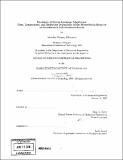Mechanics of proton exchange membranes : time, temperature, and hydration dependence of the stress-strain behavior of persulfonated polytetrafluorethylene
Author(s)
Silberstein, Meredith N
DownloadFull printable version (28.01Mb)
Other Contributors
Massachusetts Institute of Technology. Dept. of Mechanical Engineering.
Advisor
Mary C. Boyce.
Terms of use
Metadata
Show full item recordAbstract
Fuel cells are an important part of the future strategy for reducing dependence on fossil fuels as the world's supplies become more limited and greenhouse gasses become more of a concern. Proton Exchange Membrane Fuel Cells (PEMFC), in which protons from hydrogen gas are passed across a membrane to react with oxygen gas producing electricity, with water as the only waste product, are a cleaner and potentially more efficient chemical energy conversion method. However, the current usefulness of PEMFC is limited by the lifespan and high cost of the fuel cell unit, and more specifically the membrane electrode assembly (MEA). At the center of most contemporary MEA is a thin membrane (- 25 - 100pm thick) of persulfonated polytetrafluoroethylene manufactured by Dupont and known commercially as Nafion. Nafion has the unique quality of being microphase separated into hydrophobic and hydrophilic domains composed of backbone rich and sulfonic acid side chain rich regions respectively. This polymer electrolyte membrane is responsible for rapidly conducting the protons from the hydrogen side to the oxygen side while preventing electrons, hydrogen, and oxygen from passing through. Because of this selective permeability requirement it is important that the membrane possess good mechanical durability so that it does not form pinholes during operation (something which it has been shown to do experimentally). The goal of this thesis was to develop an understanding of the mechanical properties of Nafion as well as a comprehensive material model that captures all the features that are important to how a membrane deforms in an operational fuel cell, including the time, temperature, and hydration dependence of the elastic regime, yield, strain hardening, and stress relaxation at low to moderate strains. (cont) In order to accomplish this understanding a comprehensive experimental study was undertaken in which Nafion was characterized in uniaxial tension under monotonic, cyclic, and stress relaxation loading profiles at strain rates from 0.001/s to 0.1/s, temperatures from 250C to 1000C, and from dry to fully hydrated conditions. The evolution of the microstructure with applied deformation was then investigated with diffraction techniques. Wide and small angle x-ray scattering data was collected during uniaxial tensile monotonic extension, cyclic, and stress relaxation loading profiles. The SAXS peaks and two WAXS peaks were seen to be isotropic in the initial state. Their evolution with strain was interpreted to indicate that the ionic clusters deform to an elliptical shape with major axis parallel to the tensile direction with an applied strain, whereas the backbone segments align themselves parallel to the tensile direction with an applied strain. Combining these results with those in literature we revise an existing conceptual model for how each of the micromechanical features evolves with strain and how that contributes to the stress response. From mechanical and microstructural data, a constitutive model was developed which is able to capture the key features of the mechanical behavior of Nafion as functions of time, temperature, and hydration. The model is then applied to a simulated fuel cell. The results from the fuel cell simulations indicate that the hypothesis that cyclic stress states and permanent membrane deformation result from hygro-thermal cycling and can lead to pinhole formation.
Description
Thesis (S.M.)--Massachusetts Institute of Technology, Dept. of Mechanical Engineering, 2008. Includes bibliographical references (leaves 169-170).
Date issued
2008Department
Massachusetts Institute of Technology. Department of Mechanical EngineeringPublisher
Massachusetts Institute of Technology
Keywords
Mechanical Engineering.